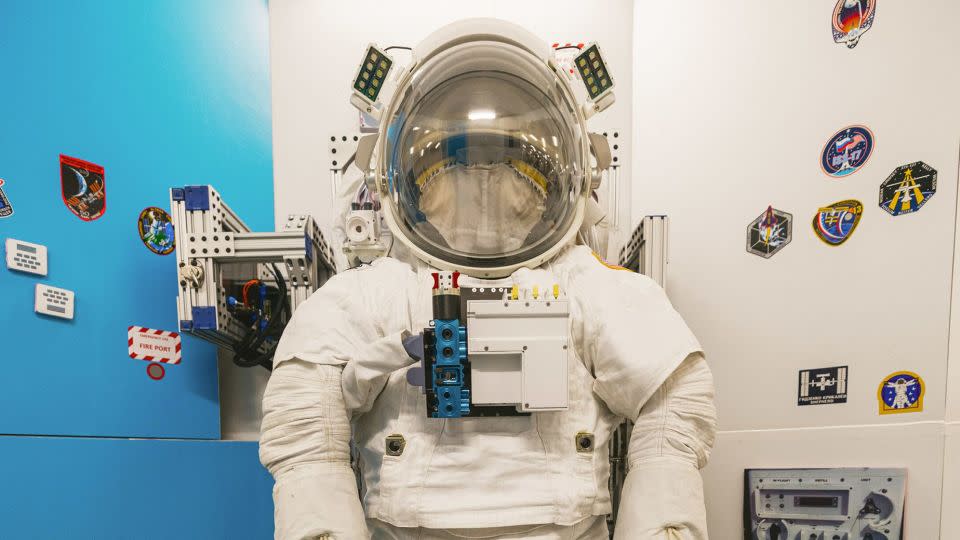Bronze Age workshop reveals precious pigment made from a recipe lost to time
Editor’s note: A version of this story appeared in CNN’s Wonder Theory science newsletter. To get it in your inbox, sign up for free here.
History is full of vanished arts and techniques that researchers are still trying to crack, such as decoding heirloom recipes lost to time. Some of those formulations belong to vivid colors that our ancestors developed millennia ago.
It’s easy to think of the past as a sepia-toned expanse. Over time, paint has flecked away from objects, and dyes have faded from disintegrating fabrics.
But civilizations that lived thousands of years ago were awash in a vibrant array of colors.
Generations of artisans worked to achieve brilliant hues, such as the perfect shade of blue. And microscopic traces have revealed that floral motifs once bedecked Greek marble statues.
Now, researchers may have uncovered the secret to one of the most treasured colors of all time.
A long time ago

Ancient Greeks and the Romans considered Tyrian purple, first developed in the Bronze Age, an elite, royal color. But the recipe for the long-lasting pigment, made using Mediterranean sea snails, disappeared with the fall of the Byzantine Empire.
Now, researchers have found the precious pigment within pottery fragments containing 3,600-year-old purple dye from a Bronze Age workshop in Kolonna on the Greek island of Aegina.
The pigment, discovered alongside crushed mollusk shells and stone tools, could still be used to dye fabrics now, according to the researchers — although they uncovered a new mystery in the artisan process.
We are family
A fossilized ear bone found in a cave in Spain is helping to tell the story of a Neanderthal child with Down syndrome who was cared for by the youngster’s community.
The child, who lived about 146,000 years ago, likely experienced severe hearing loss, vertigo and balance issues, and abnormalities in the inner ear suggest the youth had Down syndrome.
Life for a vulnerable child in the Stone Age would have been difficult because Neanderthals moved from place to place. It was surprising that the child lived until the age of 6, said paleoanthropologist Mercedes Conde-Valverde, an assistant professor at the University of Alcalá in Spain.
“For decades, it has been known that Neanderthals cared for and looked after their vulnerable companions,” Conde-Valverde said. “What was not known until now was a case of an individual who had received extra-maternal care from birth, even though it could not reciprocate.”
Defying gravity

The spacesuits regularly worn by NASA astronauts that allow them to conduct spacewalks outside the International Space Station are steadily aging, but Collins Aerospace and NASA have ceased their plans to develop new ones.
The announcement came as a coolant leak in the spacesuit worn by NASA astronaut Tracy Dyson halted plans for a spacewalk this week.
NASA and Boeing are now considering extending the stay of the Starliner crew aboard the space station up to three months as they continue to assess issues with the spacecraft.
Meanwhile, the agency has selected SpaceX to design a vehicle that will drag the space station out of orbit at the end of the decade when it ceases operations and plummets into the ocean.
Other worlds
The first in-depth look at a sample collected from the asteroid Bennu by NASA’s OSIRIS-REx mission has revealed that the space rock may have had a watery past.
Organic compounds necessary for life were in the sample, similar to those found at mid-ocean ridges on Earth — and researchers now think Bennu may have splintered from an ancient ocean world.
Separately, China’s Chang’e-6 lunar module has returned to Earth with its precious cache containing the first samples ever returned from the lunar far side.
And data from NASA’s retired InSight mission has revealed that Mars gets hit by hundreds of basketball-size space rocks every year — and two football field-size impacts occurred when astronomers were watching.
Force of nature

The Reykjanes Peninsula of Iceland experienced 800 years of quiet, but that all changed in 2021 when volcanoes there began to wake up. Now, new research identifying a main source fueling the hotbed of activity suggests that the eruptions could continue for years or even decades.
Local communities such as Grindavík, a fishing town of over 3,000 residents near the country’s iconic Blue Lagoon tourist attraction, may be forced into a long-term evacuation going forward.
Meanwhile, despite the fact that Mount Rainier in Washington state hasn’t erupted in the past 1,000 years, it’s the one that concerns US volcanologists the most.
Curiosities
Share these new stories with your friends:
— Elite men served as scribes and recorded events during the height of ancient Egyptian society — and the administrative roles left unusual marks on their skeletons, including their spines and jaws.
— This week, a new satellite launched to monitor space weather as solar activity ramps up, and it could provide advance warnings of solar storms erupting from the sun.
— The anatomy of a fossil belonging to an ancient sea creature puzzled scientists until they realized it was upside down.
— Wood samples, a twig, an animal bone and a cache of ancient almonds have helped researchers uncover when the Kyrenia, a famous Greek Hellenistic-period ship, really sank.
Like what you’ve read? Oh, but there’s more. Sign up here to receive in your inbox the next edition of Wonder Theory, brought to you by CNN Space and Science writers Ashley Strickland and Katie Hunt. They find wonder in planets beyond our solar system and discoveries from the ancient world.
For more CNN news and newsletters create an account at CNN.com

 Yahoo News
Yahoo News 
